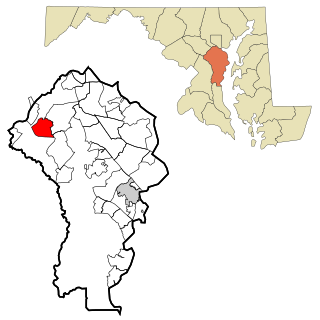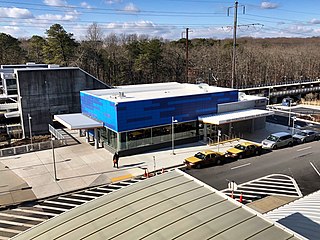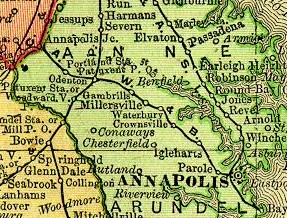
Fort Meade is a census-designated place (CDP) in Anne Arundel County, Maryland, United States. The population was 9,327 at the 2010 census. It is the home to the National Security Agency, Central Security Service, United States Cyber Command and the Defense Information Systems Agency, which are located on the U.S. Army post Fort George G. Meade.

Odenton is a census-designated place (CDP) in Anne Arundel County, Maryland, United States, located approximately 10–20 minutes from the state capital, Annapolis. The population was 37,132 at the 2010 census, up from 20,534 at the 2000 census. The town's population growth rate of 80.8% between 2000 and 2010 was the greatest of any town in western Anne Arundel County. Odenton is located west of Annapolis, south of Baltimore, and northeast of Washington, D.C..

The Maryland Area Rail Commuter (MARC) is a commuter rail system in the Washington–Baltimore area. MARC is administered by the Maryland Transit Administration (MTA) and operated under contract by Alstom and Amtrak on track owned by CSX Transportation (CSXT) and Amtrak. In 2023, the system had a ridership of 3,860,600, or about 13,900 per weekday as of the third quarter of 2024, less than pre-COVID-19 pandemic weekday ridership of 40,000.

Baltimore Penn Station—formally, Baltimore Pennsylvania Station—is the main inter-city passenger rail hub in Baltimore, Maryland. Designed by New York City architect Kenneth MacKenzie Murchison (1872–1938), it was constructed in 1911 in the Beaux-Arts style of architecture for the Pennsylvania Railroad. It is located at 1515 N. Charles Street, about a mile and a half north of downtown and the Inner Harbor, between the Mount Vernon neighborhood to the south, and Station North to the north. Originally called Union Station because it served the Pennsylvania Railroad and Western Maryland Railway, it was renamed to match the PRR's other main stations in 1928.

Newark Penn Station is an intermodal passenger station in Newark, New Jersey. One of the New York metropolitan area's major transportation hubs, Newark Penn Station is served by multiple rail and bus carriers, making it the seventh busiest rail station in the United States, and the fourth busiest in the New York City metropolitan area.

BWI Rail Station is an intermodal passenger station in Linthicum, Maryland near Baltimore/Washington International Airport (BWI). It is served by Amtrak Northeast Corridor intercity trains, MARC Penn Line regional rail trains, and several local bus lines.

The Baltimore and Potomac Railroad (B&P) operated from Baltimore, Maryland, southwest to Washington, D.C., from 1872 to 1902. Owned and operated by the Pennsylvania Railroad, it was the second railroad company to connect the nation's capital to the Northeastern U.S., and competed with the older Baltimore and Ohio Railroad.

West Baltimore station is a commuter rail station located in the western part Baltimore, Maryland, along the Northeast Corridor. It is served by MARC Penn Line trains. The station is positioned on an elevated grade at 400 Smallwood Street near parallel West Mulberry and West Franklin Streets extending off U.S. Route 40. Three large surface lots are available for commuters. The station only has staircases from street level and two low-level side platforms next to the outer tracks and is thus not accessible to people with some mobility disabilities, but MTA Maryland plans to renovate the station with accessible platforms and entrances.

Maryland Route 175 is a state highway in the U.S. state of Maryland. The highway runs 17.01 miles (27.37 km) from Little Patuxent Parkway in Columbia east to MD 3 in Millersville. MD 175 is a major highway through the large unincorporated community of Columbia; the highway connects U.S. Route 29 next to Columbia Town Center with Interstate 95 (I-95) and an industrial area on the eastern side of Howard County. MD 175 also connects Fort Meade with Jessup and Odenton in western Anne Arundel County, where it links MD 295 and MD 32 with the eastern part of the U.S. Army base.

Maryland Route 170 is a state highway in the U.S. state of Maryland. The state highway runs 12.98 miles (20.89 km) from MD 175 in Odenton north to MD 2 in Brooklyn Park. MD 170 connects the western Anne Arundel County communities of Odenton and Severn and the North County communities of Linthicum, Pumphrey, and Brooklyn Park with Baltimore/Washington International Thurgood Marshall Airport. The highway connects BWI Airport with Interstate 695 (I-695) and MD 100 and forms part of the Airport Loop, a circumferential highway that connects the airport and I-195 with many airport-related services.

The Annapolis and Elk Ridge Railroad, later the Annapolis, Washington and Baltimore Railroad, was a railroad that provided service to Annapolis, Maryland from the Baltimore and Ohio's Washington Branch from 1840 to 1935. It was one of the earliest railroads in the U.S. It later merged into the Washington, Baltimore and Annapolis Electric Railway and was finally abandoned. The right-of-way is now primarily used as a utility corridor, with roads and trails on some sections. A few small sidings and two short sections of rail, of which only one is still in use, and some bridges still remain.

Aberdeen station is a train station in Aberdeen, Maryland, on the Northeast Corridor. It is served by Amtrak Northeast Regional intercity service and MARC Penn Line commuter service. The station has two side platforms serving the outer tracks of the three-track Northeast Corridor, with a station building on the north side of the tracks.

The Penn Line is a MARC passenger rail service operating between Union Station in Washington, D.C., and Perryville, Maryland, along the far southern leg of the Northeast Corridor; most trains terminate at Baltimore's Penn Station. It is MARC's only electrified line, though a majority of trains remain diesel powered. With trains operating at speeds of up to 125 miles per hour (201 km/h), it is the fastest commuter rail line in the United States. The service is operated by Amtrak under contract to the Maryland Transit Administration. MARC sets the schedules, owns most of the stations, and controls fares, while Amtrak owns and maintains the right-of-way, supplies employees to operate trains, and maintains the rolling stock. It is the busiest of MARC's three lines, with twice as many trains and riders as the Brunswick and Camden lines combined.

Perryville station is a passenger rail station on the Northeast Corridor in Perryville, Maryland. It is the northern terminus of the MARC Penn Line. The station has a single side platform serving the northern track of the four-track Northeast Corridor. The station building houses the Perryville Railroad Museum, which includes a model train layout and exhibits about the history of railroads in Perryville.

Edgewood station is a passenger rail station on the Northeast Corridor in the unincorporated community of Edgewood, Maryland, served by the MARC Penn Line. Edgewood station serves the southern terminus of Maryland Route 755 which terminates at an entrance to the Aberdeen Proving Ground. The station has two side platforms with a small station building north of the tracks. Parking is located on either side of the station area.

Bowie State station is a regional rail station on the Northeast Corridor, located adjacent to the campus of Bowie State University in Bowie, Maryland. It is served by MARC Penn Line commuter rail trains. The station is located on a three-track section of the Northeast Corridor, with two side platforms next to the outer tracks.

The Bowie Railroad Buildings comprise three small frame structures at the former Bowie train station, located at the junction of what is now the Northeast Corridor and the Pope's Creek Subdivision in the town center of Bowie, Maryland. The complex includes a single-story freight depot, a two-story interlocking tower, and an open passenger shed. The station was served by passenger trains from 1872 until 1989, when it was replaced by Bowie State station nearby. The buildings were restored in 1992 as the Bowie Railroad Museum and added to the National Register of Historic Places in 1998.

Elkton station is a former passenger rail station located in Elkton, Maryland. The last passenger service to the station was Amtrak's Chesapeake from 1978 to 1983. The brick station building still remains along the Northeast Corridor tracks.
Lanham station was a regional rail station on the Northeast Corridor, located just outside the Capital Beltway off Route 450 in Lanham, Maryland. It was served by the predecessor of today's MARC Penn Line, until August 1982.




















